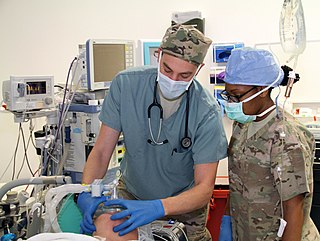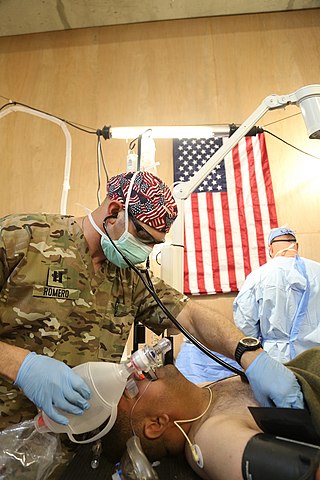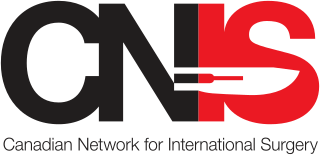
Surgery is a medical specialty that uses manual and/or instrumental techniques to physically reach into a subject's body in order to investigate or treat pathological conditions such as a disease or injury, to alter bodily functions, to improve appearance, or to remove/replace unwanted tissues or foreign bodies. The subject receiving the surgery is typically a person, but can also be a non-human animal.
A trauma center, or trauma centre, is a hospital equipped and staffed to provide care for patients suffering from major traumatic injuries such as falls, motor vehicle collisions, or gunshot wounds. A trauma center may also refer to an emergency department without the presence of specialized services to care for victims of major trauma.

Anesthesiology, anaesthesiology, or anaesthesia is the medical specialty concerned with the total perioperative care of patients before, during and after surgery. It encompasses anesthesia, intensive care medicine, critical emergency medicine, and pain medicine. A physician specialized in anesthesiology is called an anesthesiologist, anaesthesiologist, or anaesthetist, depending on the country. In some countries, the terms are synonymous, while in other countries, they refer to different positions and anesthetist is only used for non-physicians, such as nurse anesthetists.

A nurse anesthetist is an advanced practice nurse who administers anesthesia for surgery or other medical procedures. They are involved in the administration of anesthesia in a majority of countries, with varying levels of autonomy.

A Certified Registered Nurse Anesthetist (CRNA) is a type of advanced practice nurse who administers anesthesia in the United States. CRNAs account for approximately half of the anesthesia providers in the United States and are the main providers (80%) of anesthesia in rural America. Historically, nurse anesthetists have been providing anesthesia care to patients for over 150 years since the American Civil War and the CRNA credential came into existence in 1956. CRNA schools issue a doctorate of nursing anesthesia degree to nurses who have completed a program in anesthesia, which is roughly 3 years in length.
Oral and maxillofacial surgery is a surgical specialty focusing on reconstructive surgery of the face, facial trauma surgery, the oral cavity, head and neck, mouth, and jaws, as well as facial cosmetic surgery/facial plastic surgery including cleft lip and cleft palate surgery.

A surgical technologist, also called a scrub, scrub tech, surgical technician, or operating department practitioner or operating room technician, is an allied health professional working as a part of the team delivering surgical care. Surgical technologists are members of the surgical team. The members of the team include the surgeon, surgeon's assistant, circulator nurse and anesthesia provider. They possess knowledge and skills in sterile and aseptic techniques. There are few mandatory professional requirements for surgical technologists, and the scope of practice varies widely across countries and jurisdictions. Surgical technologists attend junior colleges and technical schools, and many are trained in military schools. In the military they perform the duties of both the circulator and the scrub. The goal is for surgical technologists to be able to anticipate the next move the surgeon is going to make in order to make the procedure as smooth and efficient as possible. They do this by having knowledge of hundreds of surgical procedures and the steps the surgeon needs to take in order to complete the procedure, including the very wide range of surgical instruments they may need. Specialties can include, but are not limited to, the following: genitourinary, obstetrics and gynaecology, urology, ENT, plastics, general, orthopedics, neurology, and cardiovascular. They only work in surgical or perioperative areas and are highly specialized. Surgical technologist is the proper term for a two-year program which earns a degree in applied sciences. The profession is up and coming and highly in demand.

A feldsher is a health care professional who provides various medical services limited to emergency treatment and ambulance practice. As such, a feldsher is one kind of mid-level medical practitioner.

Mercy Ships is an international charity based on Christian values that operates the largest non-governmental hospital ships in the world, providing hope and healing in Africa through surgical care and surgical education, community development projects, community health education, mental health programs, agriculture projects, and palliative care for terminally ill patients. Its headquarters are in Garden Valley, Texas.

The Canadian Network for International Surgery (CNIS) is a non-profit organization that promotes the delivery of essential surgical care to underprivileged people in low-income countries. Its objective is also to reduce death and disability caused by any disturbances in normal functioning of the mind or the body that would require surgery. The CNIS emphasizes education in surgical work and techniques. It also works in surgical development and research.

In modern medicine, a surgeon is a medical doctor who performs surgery. Although there are different traditions in different times and places, a modern surgeon is also a licensed physician or received the same medical training as physicians before specializing in surgery.

Operating room management is the science of how to run an operating room suite. Operational operating room management focuses on maximizing operational efficiency at the facility, i.e. to maximize the number of surgical cases that can be done on a given day while minimizing the required resources and related costs. For example, what is the number of required anaesthetists or the scrub nurses that are needed next week to accommodate the expected workload or how can we minimize the cost of drugs used in the Operating Room? Strategic operating room management deals with long-term decision-making. For example, is it profitable to add two additional rooms to the existing facility? Typically, operating room management in profit-oriented health-care systems emphasizes strategic thinking whereas in countries with publicly funded health care, the focus is on operational decisions.

The Erlanger Health System, incorporated as the Chattanooga-Hamilton County Hospital Authority, a non-profit, public benefit corporation registered in the State of Tennessee, is a system of hospitals, physicians, and medical services based in Chattanooga, Tennessee. Erlanger's main location, Erlanger Baroness Hospital, is a tertiary referral hospital and Level I Trauma Center serving a 50,000 sq mi (130,000 km2) region of East Tennessee, North Georgia, North Alabama, and western North Carolina. The system provides critical care services to patients within a 150 mi (240 km) radius through six Life Force air ambulance helicopters, which are equipped to perform in-flight surgical procedures and transfusions.

Sharp Memorial Hospital is a hospital in San Diego, California, in the United States. Opened in 1955, Sharp Memorial is Sharp HealthCare's largest hospital and the system's only designated Level II trauma center. Located in Serra Mesa, the hospital has 656 beds, including 48 for intensive-care services.

McLaren Flint is a nonprofit, 378 bed tertiary teaching hospital located in Flint, Michigan. McLaren is affiliated with the Michigan State University College of Human Medicine's medical residency programs, including family medicine, internal medicine, general surgery, orthopedic surgery and radiology. McLaren also maintains a hematology/oncology fellowship program in partnership with Michigan State University and is sponsoring a surgical oncology fellowship program. McLaren Flint is a subsidiary of McLaren Health Care Corporation.
The World Health Organization (WHO) published the WHO Surgical Safety Checklist in 2008 in order to increase the safety of patients undergoing surgery. The checklist serves to remind the surgical team of important items to be performed before and after the surgical procedure in order to reduce adverse events such as surgical site infections or retained instruments. It is one affordable and sustainable tool for reducing deaths from surgery in low and middle income countries.

Kathryn Ann Kelly "Kelly" McQueen is an American anesthesiologist and global health expert. She currently practices anesthesiology at the UW Health University Hospital in Madison, Wisconsin and serves as the chair for the Department of Anesthesiology at the University of Wisconsin School of Medicine and Public health.
The Alliance for Surgery and Anesthesia Presence is a multidisciplinary society of surgeons, anesthesiologists, obstetricians and public health specialists organized to improve the delivery of surgical care, particularly in low and middle income countries. The body, named the Burden of Surgical Disease Working Group at its founding in 2007, was renamed in 2010. It became an international society in 2013 under the umbrella of the International Surgery Society.

The COVID-19 pandemic has impacted hospitals around the world. Many hospitals have scaled back or postponed non-emergency care. This has medical consequences for the people served by the hospitals, and it has financial consequences for the hospitals. Health and social systems across the globe are struggling to cope. The situation is especially challenging in humanitarian, fragile and low-income country contexts, where health and social systems are already weak. Health facilities in many places are closing or limiting services. Services to provide sexual and reproductive health care risk being sidelined, which will lead to higher maternal mortality and morbidity. The pandemic also resulted in the imposition of COVID-19 vaccine mandates in places such as California and New York for all public workers, including hospital staff.
Global neurosurgery is a field at the intersection of public health and clinical neurosurgery. It aims to expand provision of improved and equitable neurosurgical care globally.













